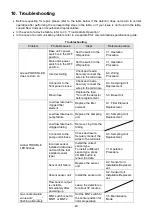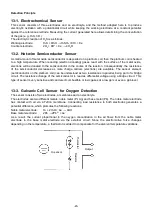
-45-
Detection Principle
13-1. Electrochemical Sensor
This sensor consists of three electrodes and an electrolyte, and the method adopted here is to produce
electrolytic oxidation with a potentiostat circuit while keeping the working electrode at a constant potential
against the reference electrode. Measuring the current generated here allows determining the concentration
of the gas (e.g., H
2
S, CO).
The electrolytic reaction of H
2
S is as follows:
Working electrode:
H
2
S + 4H
2
O
H
2
SO
4
+8H+ + 8e
Counter electrode:
2O
2
+ 8H
+
+ 8e
4H
2
O
13-2. Hot-wire Semiconductor Sensor
A small amount of metal oxide semiconductor is deposited on a platinum coil, then the platinum coil is heated
to a high temperature. When reducing (electron donating) gases react with the surface of the metal oxide,
electrons will be donated to the semiconductor in the course of the reaction. Consequentially, the resistance
of the semiconductor decreases as more charge carriers (electrons) are available. The sensor element
(semiconductor on the platinum coil) can be understood as two resistances in parallel, being part of a bridge
circuit. The resistance change of the semiconductor is read as differential voltage using a bridge circuit. This
type of sensor is very sensitive and can detect combustible or toxic gases at a low ppm or even a ppb level.
13-3. Galvanic Cell Sensor for Oxygen Detection
The sensor consists of two electrodes, a membrane and an electrolyte.
The electrodes are two different metals, noble metal (Pt, Ag) and base metal (Pb). The noble metal electrode
has contact with air via a Teflon membrane. Connecting load resistance to both electrodes generates a
potential difference, which promotes the following reactions:
Noble metal electrode:
O
2
+ 2H
2
O + 4e
4OH
Base metal electrode:
2Pb
2Pb
2+
+ 4e
As a result, the current proportional to the oxygen concentration in the air flows from the noble metal
electrode to the base metal electrode via the external circuit. Since the electromotive force changes
depending on the temperature, a thermistor is added to compensate for the ambient temperature variations.
O
2
sensor
T
he
rmi
s
tor
Res
is
tor
Output


































